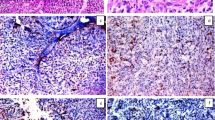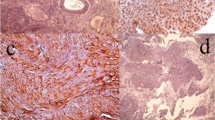Abstract
Purposes
To describe the differential tissue expression of tumor-associated trypsin inhibitor (TATI) in normal bladder urothelium, primary urothelial carcinoma of the bladder (UCB) and metastatic UCB and to assess the association of TATI expression with molecular markers commonly altered in UCB and clinical outcomes after radical cystectomy.
Methods
Slides from eight cystectomy patients without cancer, 191 radical cystectomy patients, 20 lymph nodes without metastasis and 40 lymph nodes with UCB were stained. Tissue expression of TATI, cyclin E1, cyclin D1, p53, p21, p27, pRB, Ki-67, Bcl-2, Caspase-3, Survivin and Cyclooxigenase-2 was measured in a tissue microarray. Cancer-specific and recurrence-free survival after radical cystectomy was recorded.
Results
TATI was expressed in 100% of patients without cancer, while 71% of radical cystectomy specimens and 90% of lymph node metastases exhibited decreased or no TATI expression. In radical cystectomy specimens, TATI expression decreased with advancing pathologic stage (P < 0.001) and lymphovascular invasion (P = 0.055). In univariate analyses, but not in multivariable Cox proportional hazard regression analyses, decreased TATI expression was associated with increased probability of tumor recurrence and cancer-specific mortality. Decreased TATI expression was correlated with altered expression of Cyclooxigenase-2 (P = 0.005), p21 (P = 0.035) and Ki-67 (P = 0.004).
Conclusions
We found that normal urothelium expresses TATI and that TATI expression decreases with advancing tumor stage. While there was no prognostic benefit to TATI when adjusted for standard clinicopathologic features, it seems to play an important biologic role in UCB pathogenesis and invasion. Its association with markers involved in the cell cycle, proliferation and inflammation serves as hypothesis for molecular interactions.


Similar content being viewed by others
References
Koivunen E, Ristimaki A, Itkonen O, Osman S, Vuento M, Stenman UH (1991) Tumor-associated trypsin participates in cancer cell-mediated degradation of extracellular matrix. Cancer Res 51:2107–2112
Yamamoto H, Iku S, Adachi Y, Imsumran A, Taniguchi H, Nosho K, Min Y, Horiuchi S, Yoshida M, Itoh F et al (2003) Association of trypsin expression with tumour progression and matrilysin expression in human colorectal cancer. J Pathol 199:176–184
Moilanen M, Sorsa T, Stenman M, Nyberg P, Lindy O, Vesterinen J, Paju A, Konttinen YT, Stenman UH, Salo T (2003) Tumor-associated trypsinogen-2 (trypsinogen-2) activates procollagenases (MMP-1, -8, -13) and stromelysin-1 (MMP-3) and degrades type I collagen. Biochemistry 42:5414–5420
Paju A, Vartiainen J, Haglund C, Itkonen O, von Boguslawski K, Leminen A, Wahlstrom T, Stenman UH (2004) Expression of trypsinogen-1, trypsinogen-2, and tumor-associated trypsin inhibitor in ovarian cancer: prognostic study on tissue and serum. Clin Cancer Res 10:4761–4768
Huhtala ML, Pesonen K, Kalkkinen N, Stenman UH (1982) Purification and characterization of a tumor-associated trypsin inhibitor from the urine of a patient with ovarian cancer. J Biol Chem 257:13713–13716
Wiksten JP, Lundin J, Nordling S, Kokkola A, Stenman UH, Haglund C (2005) High tissue expression of tumour-associated trypsin inhibitor (TATI) associates with a more favourable prognosis in gastric cancer. Histopathology 46:380–388
Turpeinen U, Koivunen E, Stenman UH (1988) Reaction of a tumour-associated trypsin inhibitor with serine proteinases associated with coagulation and tumour invasion. Biochem J 254:911–914
Stenman UH (2002) Tumor-associated trypsin inhibitor. Clin Chem 48:1206–1209
Ozaki N, Ohmuraya M, Hirota M, Ida S, Wang J, Takamori H, Higashiyama S, Baba H, Yamamura K (2009) Serine protease inhibitor Kazal type 1 promotes proliferation of pancreatic cancer cells through the epidermal growth factor receptor. Mol Cancer Res 7:1572–1581
Hotakainen K, Bjartell A, Sankila A, Jarvinen R, Paju A, Rintala E, Haglund C, Stenman UH (2006) Differential expression of trypsinogen and tumor-associated trypsin inhibitor (TATI) in bladder cancer. Int J Oncol 28:95–101
Gaber A, Johansson M, Stenman UH, Hotakainen K, Ponten F, Glimelius B, Bjartell A, Jirstrom K, Birgisson H (2009) High expression of tumour-associated trypsin inhibitor correlates with liver metastasis and poor prognosis in colorectal cancer. Br J Cancer 100:1540–1548
Venesmaa P, Lehtovirta P, Stenman UH, Leminen A, Forss M, Ylikorkala O (1994) Tumour-associated trypsin inhibitor (TATI): comparison with CA125 as a preoperative prognostic indicator in advanced ovarian cancer. Br J Cancer 70:1188–1190
Venesmaa P, Stenman UH, Forss M, Leminen A, Lehtovirta P, Vartiainen J, Paavonen J (1998) Pre-operative serum level of tumour-associated trypsin inhibitor and residual tumour size as prognostic indicators in stage III epithelial ovarian cancer. Br J Obstet Gynaecol 105:508–511
Paju A, Jacobsen J, Rasmuson T, Stenman UH, Ljungberg B (2001) Tumor associated trypsin inhibitor as a prognostic factor in renal cell carcinoma. J Urol 165:959–962
Gaber A, Nodin B, Hotakainen K, Nilsson E, Stenman UH, Bjartell A, Birgisson H, Jirstrom K (2010) Increased serum levels of tumour-associated trypsin inhibitor independently predict a poor prognosis in colorectal cancer patients. BMC Cancer 10:498
Shariat SF, Herman MP, Casella R, Lotan Y, Karam JA, Stenman UH (2005) Urinary levels of tumor-associated trypsin inhibitor (TATI) in the detection of transitional cell carcinoma of the urinary bladder. Eur Urol 48(3):424–431
Kelloniemi E, Rintala E, Finne P, Stenman UH (2003) Tumor-associated trypsin inhibitor as a prognostic factor during follow-up of bladder cancer. Urology 62:249–253
Tomlins SA, Rhodes DR, Yu J, Varambally S, Mehra R, Perner S, Demichelis F, Helgeson BE, Laxman B, Morris DS et al (2008) The role of SPINK1 in ETS rearrangement-negative prostate cancers. Cancer Cell 13:519–528
Leinonen KA, Tolonen TT, Bracken H, Stenman UH, Tammela TL, Saramaki OR, Visakorpi T (2010) Association of SPINK1 expression and TMPRSS2:ERG fusion with prognosis in endocrine-treated prostate cancer. Clin Cancer Res 16:2845–2851
Shariat SF, Karakiewicz PI, Palapattu GS, Lotan Y, Rogers CG, Amiel GE, Vazina A, Gupta A, Bastian PJ, Sagalowsky AI et al (2006) Outcomes of radical cystectomy for transitional cell carcinoma of the bladder: a contemporary series from the bladder cancer research consortium. J Urol 176: 2414–2422; discussion 2422
Shariat SF, Palapattu GS, Karakiewicz PI, Rogers CG, Vazina A, Bastian PJ, Schoenberg MP, Lerner SP, Sagalowsky AI, Lotan Y (2007) Discrepancy between clinical and pathologic stage: impact on prognosis after radical cystectomy. Eur Urol 51:137–149; discussion 149–151
Shariat SF, Tokunaga H, Zhou J, Kim J, Ayala GE, Benedict WF, Lerner SP (2004) p53, p21, pRB, and p16 expression predict clinical outcome in cystectomy with bladder cancer. J Clin Oncol 22:1014–1024
Shariat SF, Zlotta AR, Ashfaq R, Sagalowsky AI, Lotan Y (2007) Cooperative effect of cell-cycle regulators expression on bladder cancer development and biologic aggressiveness. Mod Pathol 20:445–459
Karam JA, Lotan Y, Karakiewicz PI, Ashfaq R, Sagalowsky AI, Roehrborn CG, Shariat SF (2007) Use of combined apoptosis biomarkers for prediction of bladder cancer recurrence and mortality after radical cystectomy. Lancet Oncol 8:128–136
Margulis V, Shariat SF, Ashfaq R, Thompson M, Sagalowsky AI, Hsieh JT, Lotan Y (2007) Expression of cyclooxygenase-2 in normal urothelium, and superficial and advanced transitional cell carcinoma of bladder. J Urol 177:1163–1168
Margulis V, Shariat SF, Ashfaq R, Sagalowsky AI, Lotan Y (2006) Ki-67 is an independent predictor of bladder cancer outcome in patients treated with radical cystectomy for organ-confined disease. Clin Cancer Res 12:7369–7373
Benedict WF, Lerner SP, Zhou J, Shen X, Tokunaga H, Czerniak B (1999) Level of retinoblastoma protein expression correlates with p16 (MTS-1/INK4A/CDKN2) status in bladder cancer. Oncogene 18:1197–1203
Osman S, Turpeinen U, Itkonen O, Stenman UH (1993) Optimization of a time-resolved immunofluorometric assay for tumor-associated trypsin inhibitor (TATI) using the streptavidin-biotin system. J Immunol Methods 161:97–106
Grambsch PM, Therneau TM (1994) Proportional hazards tests and diagnostics based on weighted residuals. Biometrika 81:515–519
Mellon K, Wright C, Kelly P, Horne CH, Neal DE (1995) Long-term outcome related to epidermal growth factor receptor status in bladder cancer. J Urol 153:919–925
Lipponen P, Eskelinen M (1994) Expression of epidermal growth factor receptor in bladder cancer as related to established prognostic factors, oncoprotein (c-erbB-2, p53) expression and long-term prognosis. Br J Cancer 69:1120–1125
Neal DE, Sharples L, Smith K, Fennelly J, Hall RR, Harris AL (1990) The epidermal growth factor receptor and the prognosis of bladder cancer. Cancer 65:1619–1625
Cattoretti G, Becker MH, Key G, Duchrow M, Schluter C, Galle J, Gerdes J (1992) Monoclonal antibodies against recombinant parts of the Ki-67 antigen (MIB 1 and MIB 3) detect proliferating cells in microwave-processed formalin-fixed paraffin sections. J Pathol 168:357–363
Shariat SF, Ashfaq R, Sagalowsky AI and Lotan Y (2007) Predictive value of cell cycle biomarkers in nonmuscle invasive bladder transitional cell carcinoma. J Urol 177:481–487; discussion 487
Shariat SF, Matsumoto K, Kim J, Ayala GE, Zhou JH, Jian W, Benedict WF, Lerner SP (2003) Correlation of cyclooxygenase-2 expression with molecular markers, pathological features and clinical outcome of transitional cell carcinoma of the bladder. J Urol 170:985–989
Divi RL, Dragan YP, Pitot HC, Poirier MC (2001) Immunohistochemical localization and semi-quantitation of hepatic tamoxifen-DNA adducts in rats exposed orally to tamoxifen. Carcinogenesis 22:1693–1699
Bauer KD, de la Torre-Bueno J, Diel IJ, Hawes D, Decker WJ, Priddy C, Bossy B, Ludmann S, Yamamoto K, Masih AS et al (2000) Reliable and sensitive analysis of occult bone marrow metastases using automated cellular imaging. Clin Cancer Res 6:3552–3559
Mohr S, Leikauf GD, Keith G, Rihn BH (2002) Microarrays as cancer keys: an array of possibilities. J Clin Oncol 20:3165–3175
Braunschweig T, Chung JY, Hewitt SM (2005) Tissue microarrays: bridging the gap between research and the clinic. Expert Rev Proteomics 2:325–336
Shariat SF, Ashfaq R, Sagalowsky AI, Lotan Y (2006) Correlation of cyclin D1 and E1 expression with bladder cancer presence, invasion, progression, and metastasis. Hum Pathol 37:1568–1576
Shariat SF, Ashfaq R, Karakiewicz PI, Saeedi O, Sagalowsky AI, Lotan Y (2007) Survivin expression is associated with bladder cancer presence, stage, progression, and mortality. Cancer 109:1106–1113
Conflict of interest
None.
Author information
Authors and Affiliations
Corresponding author
Additional information
Oliver Patschan and Shahrokh F. Shariat contributed equally to this work.
Rights and permissions
About this article
Cite this article
Patschan, O., Shariat, S.F., Chade, D.C. et al. Association of tumor-associated trypsin inhibitor (TATI) expression with molecular markers, pathologic features and clinical outcomes of urothelial carcinoma of the urinary bladder. World J Urol 30, 785–794 (2012). https://doi.org/10.1007/s00345-011-0727-7
Received:
Accepted:
Published:
Issue Date:
DOI: https://doi.org/10.1007/s00345-011-0727-7




